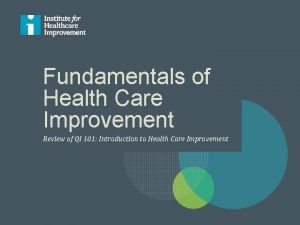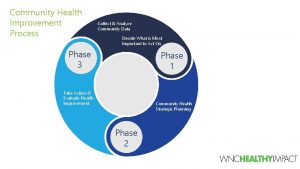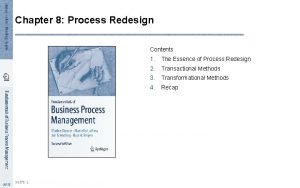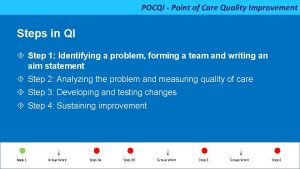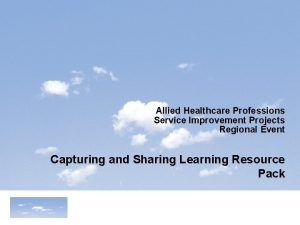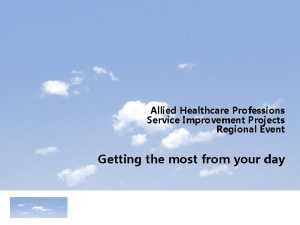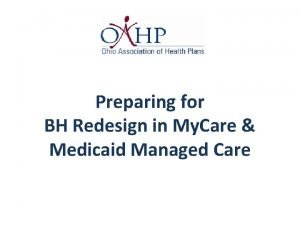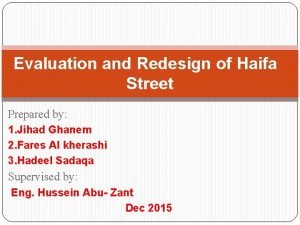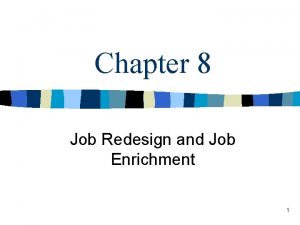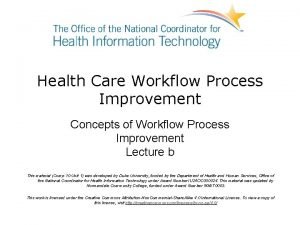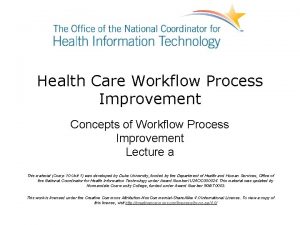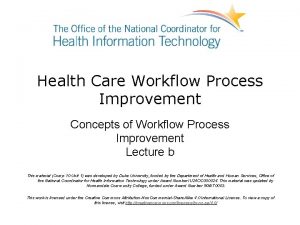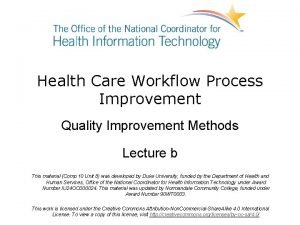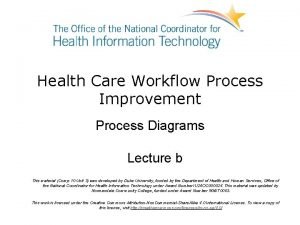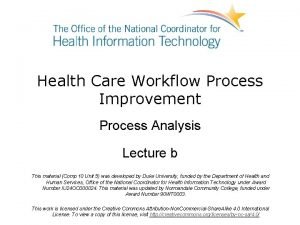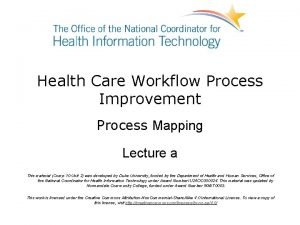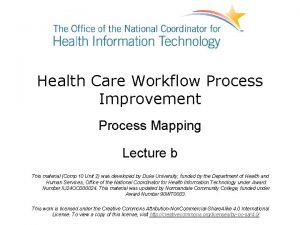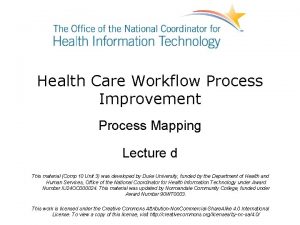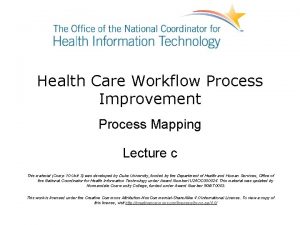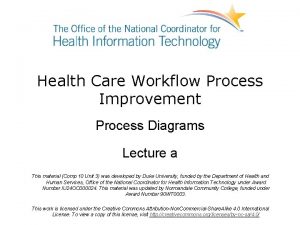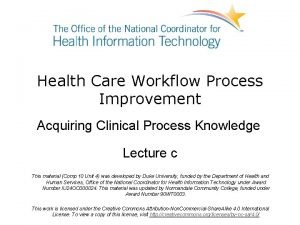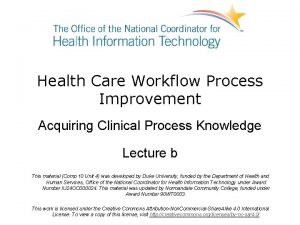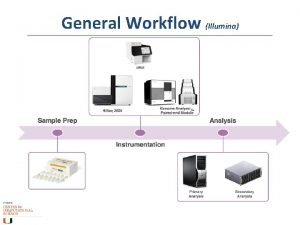Health Care Workflow Process Improvement Process Redesign Lecture





















- Slides: 21

Health Care Workflow Process Improvement Process Redesign Lecture b This material (Comp 10 Unit 6) was developed by Duke University, funded by the Department of Health and Human Services, Office of the National Coordinator for Health Information Technology under Award Number IU 24 OC 000024. This material was updated by Normandale Community College, funded under Award Number 90 WT 0003. This work is licensed under the Creative Commons Attribution-Non. Commercial-Share. Alike 4. 0 International License. To view a copy of this license, visit http: //creativecommons. org/licenses/by-nc-sa/4. 0/

Process Redesign Learning Objectives • Describe how information technology can be used to increase the efficiency of workflow in health care settings • Identify aspects of clinical workflow that are improved by EHR 2

Human-Centered Design (HCD) • HCD is an approach to systems design and development that aims to make interactive systems more usable by focusing on the use of the system and applying human factors/ ergonomics and usability knowledge and techniques. (ISO, 2010) 3

Big D and Little d • For large software systems such as electronic health records, we distinguish two types of design: – D– design of the software itself – d – configuration of the system to make it work for a particular clinic’s processes • Decisions about how electronic health record software is used in the clinic workflow heavily impacts how clinic providers and staff interact with the system. 4

Human-Centered Design Principles ISO 9241 -210 • The design is based upon an explicit understanding of users, tasks and environments • Users are involved throughout design and development • The design is driven and refined by user-centered evaluation • The process is iterative • The design addresses the whole user experience • The design team includes multidisciplinary skills and perspectives 5

ISO HCD Framework © ISO. This material is reproduced from ISO 9241 -210: 2010 with permission of the American National 6 Standards Institute (ANSI) on behalf of the International Organization for Standardization (ISO).

Integrating Process & Information Design Source: Figure from Butler 2011, used with permission 7

Design Solutions • Consider: • Sources of ideas – Using and further developing other designs – Logical progression from previous designs – Innovative creativity • Perspectives • Alignment 8

Design Methods • Leveraging and further developing other designs – Design guidelines and standards – Best practices from other industries – Other clinics which have implemented EHR – Other clinics which have a proven process that doesn't depend on EHR – Prior quality improvement projects at your clinic – Problems with current clinic workflows 9

Design Methods cont. • Logical progression from previous designs – Gap Analysis between as-is and clinic’s ideal – Leveraging technology, i. e. , automation – Workflow diagram analysis 10

Design Methods cont. • Innovative creativity – Brainstorming – Parallel Design – Storyboarding – Affinity Diagrams – Organizational Prototyping 11

Design Perspectives • Patient • Clinic providers and staff 12

Design Alignment • Organizational structures – i. e. , Roles, responsibilities, authority • • • Available talent Physical layout Information flow Information use Regulatory requirements – Accreditation and “Meaningful Use” 13

Three Key Considerations • • • Key considerations in process redesign: Clinical decision support Other Meaningful Use objectives Physical layout System interfaces 14

Impact of CDSS on Workflow • Information must be available when providers and staff need it – i. e. , At the point of decision making o Are they logged into the system? o Do they need to be or will they be in front of a computer to get the alert? o Do they need to be with the patient? o Do they have what they need to act on the alert? • Decision must be supported – Representation – Information • Right place, right time, right resources 15

Impact of Physical Location on Workflow • Location of computers • Other office hardware • Office layout: – Patient, provider and staff flow – Traffic congestion – Number of steps – Standing or sitting 16

Impact of System Interfaces on Workflow • Common interfaces – Practice Management System for billing – Local lab systems – Imaging – Local hospital – Local Health Information Exchange • Interfaces impact what information will be available electronically and when 17

Review of New Process • Providers and Staff look for: – Points of failure – Potential confusion – Bottlenecks • Design Team considerations • Technology Vendor’s determinations: – Technology Leveraged – Pot holes 18

Process Redesign Summary – Lecture b • Human-Centered Process Design • Impact on workflow of: – Clinical decision support – Physical layout – System interfaces 19

Process Redesign References – Lecture b References Butler, K. , Bahrami , A. , Esposito, C, , Hebron, A. (2000). Conceptual models for coordinating the design of user work with the design of information systems. . Data & Knowledge Engineering, 33(2), 191 -198. Butler A. (2011, May). Human Center for Design & Engineering, University of Washington, MATH Method & Tools for Evidence-based Health IT, Presentation at Duke University, Durham, NC. ISO 9241 -210: 2010(E) Ergonomics of human–system interaction —Part 210: Human-centred design for interactive systems. Retrieved from http: //www. iso. org/iso_catalogue/catalogue_ics/catalogue_detail_ics. htm? csnumber=52075 Mansar, S. L. , & Reijers, H. A. (2005). Best practices in business process redesign: validation of a redesign framework. Computers in Industry, 56, 457 -471. Retrieved from http: //is. tm. tue. nl/staff/hreijers/H. A. %20 Reijers%20 Bestanden/Mansar_2005_Computers-in. Industry. pdf Images Slide 6: ISO HCD Framework. ISO 9241 -210: 2010(E) Ergonomics of human–system interaction — Part 210: Human-centred design for interactive systems. Retrieved from http: //www. iso. org/iso_catalogue/catalogue_ics/catalogue_detail_ics. htm? csnumber=52075 Slide 7: Integrating Process and information. Image used with permission. Butler et al. (2000) 20

Process Redesign Lecture b This material was developed by Duke University, funded by the Department of Health and Human Services, Office of the National Coordinator for Health Information Technology under Award Number IU 24 OC 000024. This material was updated by Normandale Community College, funded under Award Number 90 WT 0003. 21
 Qi 101: introduction to health care improvement
Qi 101: introduction to health care improvement Community health improvement process
Community health improvement process Community health improvement process
Community health improvement process Procurement process redesign
Procurement process redesign Business process reengineering principles
Business process reengineering principles Redesign orbit
Redesign orbit 01:640:244 lecture notes - lecture 15: plat, idah, farad
01:640:244 lecture notes - lecture 15: plat, idah, farad Primary, secondary, tertiary care
Primary, secondary, tertiary care Health and social care values unit 2
Health and social care values unit 2 Health and social care component 3 health and wellbeing
Health and social care component 3 health and wellbeing Pocqi ppt
Pocqi ppt Ohio state health improvement plan
Ohio state health improvement plan The allied health profession service improvement project
The allied health profession service improvement project The allied health profession service improvement project
The allied health profession service improvement project Tdes school
Tdes school Getting organizational redesign right
Getting organizational redesign right Bh redesign
Bh redesign Pengertian job enrichment
Pengertian job enrichment Redesign haifa
Redesign haifa Job redesign meaning
Job redesign meaning Design and redesign of work systems
Design and redesign of work systems Intranet redesign
Intranet redesign
